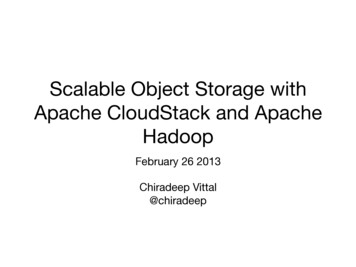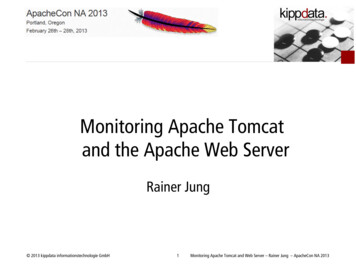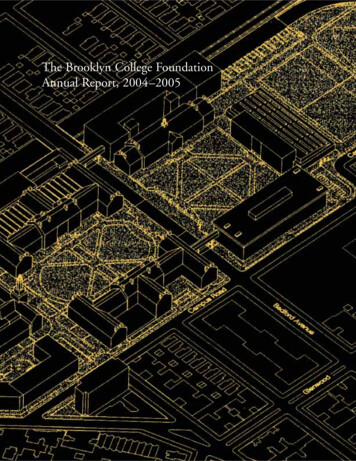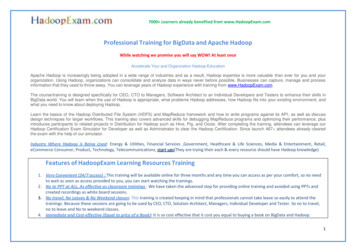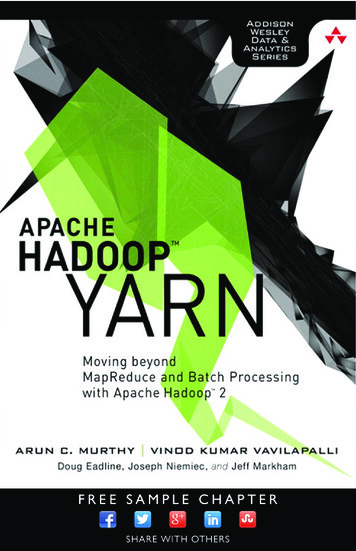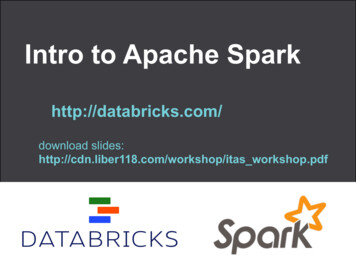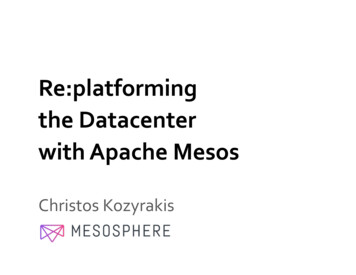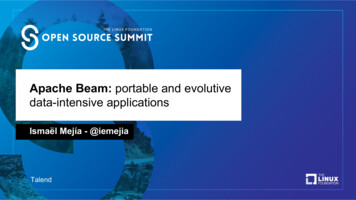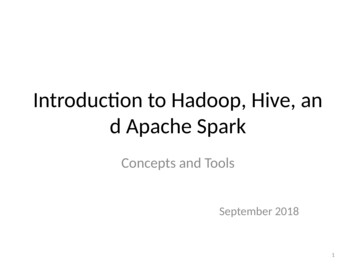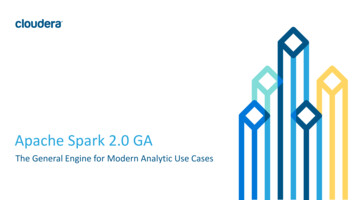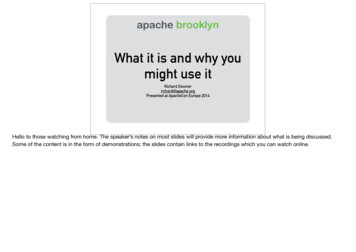
Transcription
apache brooklynWhat it is and why youmight use itRichard Downerrichard@apache.orgPresented at ApacheCon Europe 2014Hello to those watching from home. The speaker’s notes on most slides will provide more information about what is being discussed.Some of the content is in the form of demonstrations; the slides contain links to the recordings which you can watch online.
apache brooklynA brief history of Brooklyn Brooklyn was started by Cloudsoft (my employer) Open sourced in April 2012 (Apache 2 license) Joined the Apache Incubator in May 2014
apache brooklynThe only slide aboutthe company Cloudsoft use Apache Brooklyn was the base forAMP: Application Management Platform Provide commercial support and special integrationsfor Brooklyn Brooklyn is not “open core”: Cloudsoft is committed to acomprehensive and expanding Apache Brooklynfeature list and codebase but we won’t talk about Cloudsoft any more
apache brooklynThe problem with Brooklyn:How todescribe itin onesentenceThe main thing I struggle with in Brooklyn - how to describe it in one sentence - the so-called “elevator pitch”. It’s not easy to come upwith a summary which describes Brooklyn accurately, concisely, and in a way which captures Brooklyn’s unique advantages.So how do others describe Brooklyn? Let’s take a look
apache brooklynApplication modelling,monitoring and managementHere we see some attempts to describe Brooklyn succinctly.
apache brooklynBLUEPRINT FOR SUCCESS!Model, monitor and manage your applicationswith policy-based automationBlueprints are apparently something important!
apache brooklynThese taglines Are accurate Are short (mostly) Fail to provide any useful insight intowhat Brooklyn actually does
apache brooklynLet’s describe by example A simple web application: JBoss web app container MySQL databaseJBossMySQLLet’s say that we are the developers for a moderately complex web application. It needs a Java web application container for the frontend, and a MySQL database for the backend.
apache brooklynIn development You could set up your JBoss and MySQL: Run them on localhost Use Vagrant to start to two virtual machines Provision a couple of cloud instancesJBoss needs to locate MySQL Easy enough to configure this by hand
apache brooklynBut what aboutQA and production? A single web server and a singledatabase is not a productiongrade configuration! It’s not scalable: it can’t handleheavy loadJBossJBossJBossIt’s not resilient: it can’t handlefailures So we add multiple JBosses and a load balancer LoadBalancer and a MySQL standby nodeMySQLMySQLHot StandbySo this is a lot of things to be wired up!1. Everything needs a server to run on, and something needs to set up that server and install the software2. MySQL needs to know about the hot standby3. Each JBoss needs to know about the location of and credentials for MySQL4. The load balancer needs to know about the location of every JBoss
apache brooklynBut wait, there’s still more This is just for a simple application of a web server anda database! What about something with: Multiple tiers and services Connected by a message queue With multiple types of database backend SQL and NoSQL
apache brooklynMore complexityLoadBalancerNoSQL storeshardJBossJBossJBossService AMessageBrokerService BNoSQL storeshardNoSQL storeshardMySQLMySQLHot Standby
apache brooklynThe first problem How do you deploy an app with multiple components? How do you get the servers to deploy onto? How do you get the software onto servers? How do you configure the software pieces to talk to eachother? How do you make this process fast, easy and automatable?With apache brooklyn, of course!
apache brooklynThe First Pillar of BrooklynDeployment and wiring
apache brooklynObligatory page full of logosSo far we’ve used JBoss and MySQL as an example - but there are many more applications that Brooklyn supports out-of-the-box. Andmany of these can have complex deployment topologies, which Brooklyn is able to support - such as sharded databases, or databaseswhose resilience and sharding depend on a knowledge of the data centre arrangements.
apache brooklynBlueprints:how to deploy with Brooklyn Describe your application to Brooklyn make a blueprint Describe the components you are using Describe how they must be configured Describe how they relate to each other Describe where they are to be deployed
apache brooklynBlueprint for oursimple examplename: My Web Applicationlocation: AWS eu-west-1services:- serviceType: brooklyn.entity.database.mysql.MySqlNodeid: dbname: My DBbrooklyn.config:creationScriptUrl: https://bit.ly/brooklyn-visitors-creation-script- serviceType: brooklyn.entity.webapp.jboss.JBoss7Servername: My Webbrooklyn.config:wars.root: sysprops:brooklyn.example.db.url: brooklyn:formatString("jdbc:%s%s?user %s\\&password url"),"visitors", "brooklyn", "br00k11n")1. This is what a blueprint looks like - it’s a document written in YAML.2.The blueprint has a name 3. and a location. This example is deploying to a location which represents Amazon AWS EC2, region eu-west-14.Next is a list of services. The first service is the database.5.The service type is a Java class (often, but not always) - this class knows all about the software!6.It has an ID (optional) and a name.7.It also has configuration. This particular configuration references a SQL “creation” script. The MySQL entity class will read this resourceand run it as SQL on the database.8.Next we define the web server. It has similar arrangements9.The example db url is special - it calls a function, which references the database by ID, and does something called “attribute whenready”?10.To understand “attribute when ready”, it’s best to see this in action.
apache brooklynA demonstrationof deploymentWatching at home? Go to:http://youtu.be/0iJ18tlaOQk
apache brooklynAnatomy of an applicationApplicationEntityHere we’ll describe some of the parts of the Brooklyn web console. In technical terms, Brooklyn is controlled by a REST API, and this is aJavascript GUI that interacts with the REST API. So anything that can be done in the UI, can also be done by another tool interactingdirectly with the API, making Brooklyn a very powerful, scriptable component part of a larger system, if required.We can see here the “tree” structure that has an application as its root and entities as branches and leaves - although this particularexample only has a single level of entities. (We’ll see a deeper example later on.)
apache brooklynAnatomy of an entityThe summary tab shows key information about the entity or application. For a web server, the URL is “promoted” to the summary pageso it is easily accessible.
apache brooklynAnatomy of an entityBy expanding the “Config” pane, we can see some of the configuration that the entity has.
apache brooklynAnatomy of an entityThe “Sensors” tab shows detailed information about the entity. A sensor is something that the entity measures and then publishes. Herewe can see some static information about the server, but if we scroll down
apache brooklynAnatomy of an entity we can also see some dynamic sensors returning metrics about the entity, such as the number of requests and the amount of datamoved. These are updated frequently!
apache brooklynAnatomy of an entityEffectors are something that causes the entity to change in some way. “Stop” and “start” are the most obvious effectors, and these aresupported by almost all entities. The web server entities also have a “deploy” effector, which allows another web application to be loadedonto the server.We’ll skip the policies tab for now - more on that later.
apache brooklynAnatomy of an entityActivity, as you saw in the demo video, shows what tasks each entity is performing. Effector calls result in a task; and tasks can be splitinto sub-tasks. The activity view allows you to explore this hierarchy and find out the details about the success or failure of each task.
apache brooklynMake it a load-balancedweb clustername: My Web Applicationlocation: AWS eu-west-1services:- serviceType: brooklyn.entity.database.mysql.MySqlNodeid: dbname: My DBbrooklyn.config:creationScriptUrl: https://bit.ly/brooklyn-visitors-creation-script- serviceType: terbrooklyn.entity.webapp.jboss.JBoss7Servername: My Webbrooklyn.config:wars.root: sysprops:brooklyn.example.db.url: brooklyn:formatString("jdbc:%s%s?user %s\\&password url"),"visitors", "brooklyn", "br00k11n")So we’ve demonstrated a single-web-server topology. What if we wanted to make this a cluster of web servers with a load balancer? It’sincredibly easy - just a single change is required. The JBoss7Server class, and the ControlledDynamicWebAppCluster class both supportthe same interface - so by changing this one thing, we get the advanced behaviour we need.
apache brooklynMake it a load-balancedweb clusterSo in this view we can see that the JBoss entity has been replaced by several more. There is a Cluster of JBoss7Server, which is whereour cluster now lives. Because this is a “dynamic” cluster, it’s size can be changed, and there are effectors available which can do this. A“controller” cluster means that there is a controller which provides a front-end to the cluster; in this case it’s NGiNX which is acting as aload balancer. NGiNX is automatically configured with the details of the servers inside the cluster. And if the contents of the clusterchange, NGiNX is reconfigured.
apache brooklynLocations Fully “cloud aware” usingApache jclouds Amazon EC2, CloudStack, OpenStack, SoftLayer, Google GCE, Provisions instances on demand, installs andcustomises; de-provisions when no longer required Or use “BYON” - bring your own nodes Or, for testing, deploy to localhostLocations are one of the most important concepts in Brooklyn. Right from the beginning it was designed to be cloud-aware, and cloudagnostic, and as a result it’s naturally suited to deploying to many different cloud providers. Our way of doing this is with Apache jclouds,which is a Java multi-cloud toolkit - it is Brooklyn’s single most important dependency!With jclouds, your application can deploy to Amazon AWS, as demonstrated, and also CloudStack, OpenStack, SoftLayer, GoogleCompute Engine, and more.Cloud instances are provisioned when needed, software installed and then customised. When the entity is no longer needed, it isautomatically deprovisioned.If you have your own “metal” which you prefer to use, then Brooklyn can be configured with a BYON provider - “bring your own nodes”.Or, for testing your application, you can simply choose to use localhost.
apache brooklynLocations Multiple locations Multi-geography deployments reduce latency toInternational users “Fabrics” replicate an application topology into differentregions Geography-aware DNS routes visitors to closest serverAvailability zone awareness Clusters can distribute their members acrossavailability zonesAnd Brooklyn is not limited to deploying a blueprint in a single location - multiple locations can be used! A fabric will replicate a topologyin different locations; this could then be tied to a geography-aware DNS which routes users to the location nearest to them.It also allows for resilience, allowing you to have working services in different data centres, even with different cloud providers if youchoose. Some entities have a deeper level of knowledge, such as clusters which are availability-zone-aware and distribute their membersin different zones, and support for Cassandra “snitches” which introduce a degree of availability-zone-awareness to Cassandra formaximum effectiveness.
apache brooklynThe Second Pillar of BrooklynDeployment and wiring Runtime management
apache brooklynWhat isruntime management? Deployment is merely the opening move in the game Runtime management is Instructions to change the deployed application Monitor the health of all the components and react tofailures Monitor the load on the components and react torising and falling demand Optimise for cost, responsiveness, and more
apache brooklynPolicies Something that will make changes to the applicationwithout requiring operator intervention Policies are attached to an entity Monitor the entity’s sensor data and other information Makes changes to the application by invoking effectorson the entity
apache brooklynDemonstration anddescriptions of some policiesWatching at home? Go to:http://youtu.be/-WdbiDpZ8-g
apache brooklynBlueprint for a policybrooklyn.policies:- type: brooklyn.policy.ha.ServiceReplacer- type: yn.config:metric: ")metricLowerBound: 10metricLowerBound: 100minPoolSize: 2maxPoolSize: 5dynamiccluster.zone.enable: truedynamiccluster.numAvailabilityZones: 2memberSpec: brooklyn:entitySpec:type: enrichers:- type: policies:- type: :failOnRecurringFailuresInThisDuration: 30 minutesThis fragment of YAML should be appended directly onto the end of the blueprint we used earlier (but note that it has a two-space indentas it is part of the My Web entity!)Here we add two policies to the cluster - a service replacer, and an autoscaler. The autoscaler is connected to a sensor, and theconfiguration defines the thresholds and limits that the policy will operate to. We also enable options to make the cluster availability zoneaware.Member spec defines details about the entities that are used to fill the cluster - JBoss7 servers in this case. We are adding to each JBoss7 entity an enricher called ServiceFailureDetector. An enricher is something that processes sensor data and publishes another sensors; inthis case, it is monitoring key JBoss7 entity sensors and publishing a new sensor which simply says if the entity is healthy or failed.Finally, we also add to the JBoss7 entity a policy, the service restarter.
apache brooklynMore policies Optimise to minimise latency to the users:entities are moved to locations close to the users onthe network (“follow the sun”) Optimise to minimise costs:entities are moved to locations offering the lowestprices (“follow the moon”) Policies can be based on anything measurable!
apache brooklynThe Foundation of BrooklynDeployment and wiring Runtime managementAutonomic computing
apache brooklynAutonomic computing refers to the self-managing characteristics ofdistributed computing resources, adapting to unpredictable changes whilehiding intrinsic complexity to operators and users [ ] The system makesdecisions on its own, using high-level policies; it will constantly check andoptimize its status and automatically adapt itself to changing conditions. Anautonomic computing framework is composed of autonomic components(AC) interacting with each other [ ] with sensors (for self-monitoring),effectors (for self-adjustment), knowledge and planner/adapter forexploiting policies based on self- and environment awareness.https://en.wikipedia.org/wiki/Autonomic computingAutonomic computing is a key principle underlying Brooklyn. However you can use - and even develop - Brooklyn without needingdetailed knowledge about autonomics. As a case in point, I know very little about autonomic computing! I have prepared a guide to helpautonomic newbies to get started
apache brooklynThe bluffer’s guide to autonomiccomputing in Brooklyn The autonomic components are the entities Entities have: Sensors, which provide data to the external world Effectors, which cause the entity to change in some way Sensor data drives policies;policies drive effectors to make changes;a continually-adapting feedback loop Management can happen locally at the entity;or be escalated up the tree to be managed there
apache brooklynThe status ofApache Brooklyn
apache brooklynStatus update Version 0.7.0-M1 last before incubation Entered Apache Incubator in May 2014 Version 0.7.0-M2-incubating expected imminently Final 0.7.0 expected by year end Code is still in rapid development pre-1.0
apache brooklynStatus update 6 committers/PPMC members 10 mentors A number of additional developers A number of commercial customers (via Cloudsoft) A number of academic users but we are still a small community
apache brooklynHow to help We need a bigger and more diverse community so please join us! Download and run, try out deployments Share your experiences on the mailing list Bug reports, code contributions, documentationcontributions Tell us how to make it better!
apache brooklynWhere to find us Official website: https://brooklyn.incubator.apache.org Mailing tps://mail-archives.apache.org/mod mbox/incubator-brooklyn-dev/ Source r https://git-wip-us.apache.org/repos/asf?p incubator-brooklyn.git IRC channel: #brooklyncentral on Freenode
apache brooklynQuestions
apache brooklynWe are hiring! Cloudsoft are looking for great software engineers To work on Apache Brooklyn and other open source projects,and with our commercial clients who are putting it intoproduction Brooklyn is written in Java with a JavaScript front-end, butJava/JavaScript experience not an issue - because we knowthat great software engineers can adapt and learn Location not an issue - we have a distributed teamjobs@cloudsoft.io
apache brooklynStay tuned for:Clocker:Migrating Complex Applications To DockerWith Apache BrooklynPresented by Andrew Kennedy, CloudsoftNext presentation in this room
apache brooklynThank you!Richard Downerrichard@apache.org - richard@cloudsoft.ioTwitter: @FrontierTown
The load balancer needs to know about the location of every JBoss. . OpenStack, SoftLayer, Google Compute Engine, and more. Cloud instances are provisioned when needed, software installed and then customised. When the entit
